Please
Note: Firefox and some other search engines are not suitable
– Use “Internet Explorer” for this page to load
perfectly!

Click
the logo above to reach the ssMaritime FrontPage for News Updates
& “Ship of the Month”
With
Reuben Goossens
Maritime
Historian, Cruise‘n’Ship Reviewer, Author &
Lecturer
Please
Note: All ssMaritime and my other related ssMaritime sites
are 100% non-commercial and privately owned sites. Be assured
that my sites have never been associated with any cruise or
shipping companies or travel/cruise agencies or any other
organisations! The author commenced working in the Passenger
Shipping Industry back in 1960 but is now very much retired and I
hope that the well over 625 articles on classic liners and cruise
ships that I have written will continue to inform and also bring
much joy to ship enthusiasts for many more years to come!
“Orient
Steam Navigation Company”
Orient
Lines
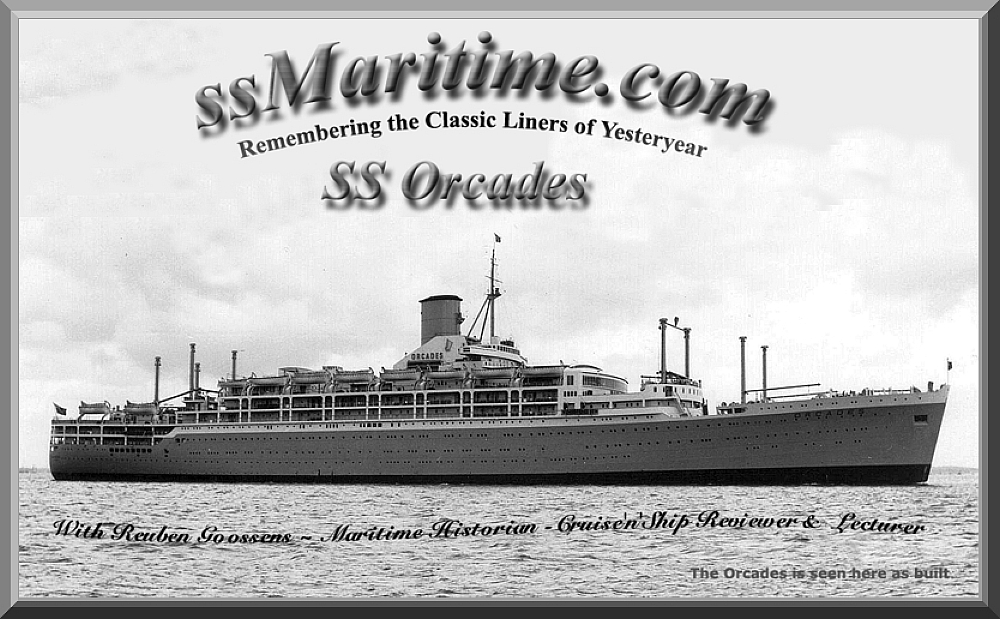
Photographs
and images on this page are from the Author’s private
collection, unless marked otherwise
Introduction
- The first SS & RMS Orcades’ of 1921 & 1937.
SS
Orcades (I):
In 1914 Orient Line was the proud owner of a
fleet some eight fine liners that operated on their Australian
service. However, by 1919 they were left with just three as well
as the new RMS Ormonde, thus they were in need of further ships
urgently! In order to re-establish Orient Line to their full
strength they needed to obtain some suitable ships and to so
three surrendered German liners were obtained to fill the gap.
The SS Orcades (I) was the second of these.
Thus obviously the 9,764 GRT (Gross Registered
Ton) SS Orcades (I) was not built for Orient Steam Navigation
Company, but she was built in 1903 at the Bremen Vulkan Ship Yard
at Vegesack for the North German Lloyd. She was launched as the
SS Prinz Ludwig on May 12, 1906. She was operated on Germany to
South American services until she was laid up in Germany from
1914 through to 1918 due to the World War I.
At the conclusion of the War, as part of the
war reparations the SS Prinz Ludwig like other German ships came
under control of the British Shipping Controller in 1919 and she
was managed for the British Government by P&O. As the War had
concluded there were countless thousands of Australian soldiers
to be repatriations from Europe and she made several voyages to Australia
in this role. Late in 1920 the Prinz Ludwig was laid up awaiting
her next role, which came quickly for Orient Line was looking for
ships.
In 1921 the Prinz Ludwig was purchased outright
by the Orient Steam Navigation Company (Orient Line) when she was
given an extensive refit and was became SS Orcades (I).
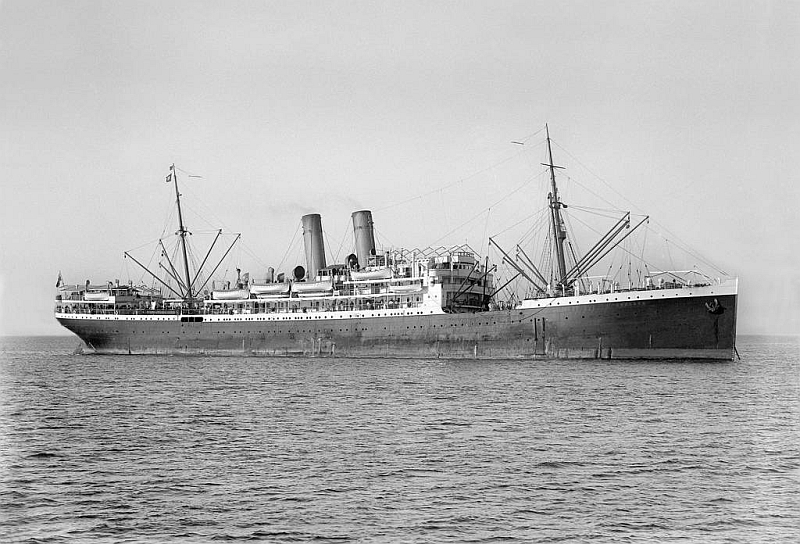
SS
Orcades (I)
After her refit she accommodated a comfortable
599 passengers, 123 First Class and 476 Third Class, and she
commenced on that very busy Australian service on October 21,
1921. Due to her slower speed she operated on a secondary
service, which was separate from the “mail service”
thus she being prefixed SS and never RMS. Although she was never
the best arrangement for Orient Line, but she was a stop gap
until Orient Line could built their new fleet of ships, the first
being to be scheduled to come into service in 1924, the next in
1925 and then the SS Orcades could be withdrawn.
She departed London for her final voyage for
Orient Line on September 20, 1924 upon her return she was placed
on the market and the Orcades was laid up but was sold in due
course and broken up at Bremerhaven Germany in 1925.
Specifications: Length: 492ft - 150m, Width:
58ft - 17.7m, Draught: 26.9ft - 8.2m. Motive Power: Quadruple
Steam Expansion Engines. Screws: Two, Speed: 15 Knots.
********************************************
RMS
Orcades (II):
The 23, 456 GRT - RMS Orcades (II) was a fine
British liner built by Vickers Armstrong Ltd, at Barrow-in-Furness,
England. She was launched by Mrs. I. C. Geddes, being the wife of
an Orient Line executive, on Tuesday December 1, 1936. She was
handed over to her owners in July 1937 and in the following month
she undertook her maiden voyage, being a 26 day Mediterranean
cruise.
Although the main reason she was built was to
operate on the UK to Australia service as a Royal Mail Ship and
she did so from 1937. RMS Orcades accommodation 463 First Class
and 605 Second (Tourist) Class passengers and her
single-reduction Parsons steam turbines drove twin screws, which
gave her an excellent service speed of 21 knots. During her two
years of service prior to the outbreak of World War II, she
became a very popular liner, both for her line voyages between England
and New Zealand and Australia as well as on cruises from London
and Southampton.
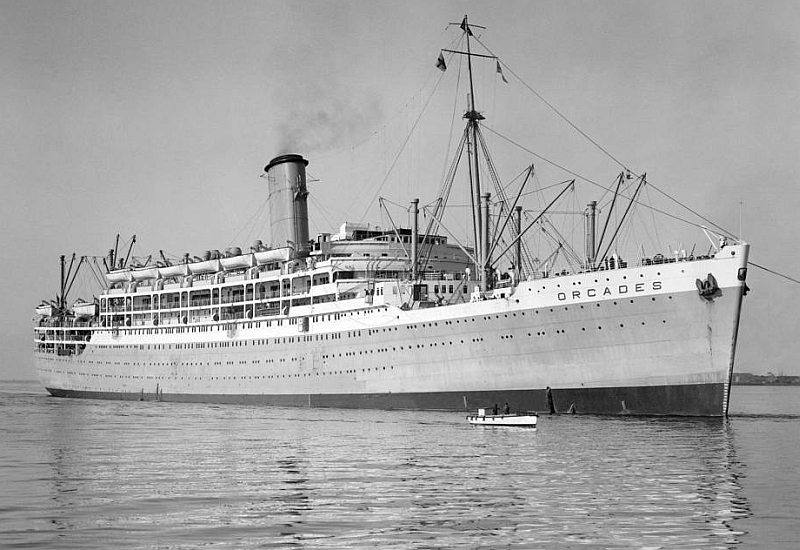
RMS
Orcades (II) - 1937-1942
She
was an improved version of her earlier sister the RMS Orion
For interest, Orcades (II) as well as her
sister ship, RMS Orion’s interior décor and fittings had
been designed by New Zealand born modernist architect Mr. Brian O’Rorke.
But, with the war having commenced, in 1939,
she was requisitioned by the British Government to be refitted to
become a troopship and she was given the prefix of HMT (His
Majesty Trooper) in that same year. She served valiantly however
tragically disaster awaited this superb liner/trooper within a
short few years.
During 1940, 41 and 42 the HMT Orcades carried
troops to the various theatres of war, and wherever they were
needed.
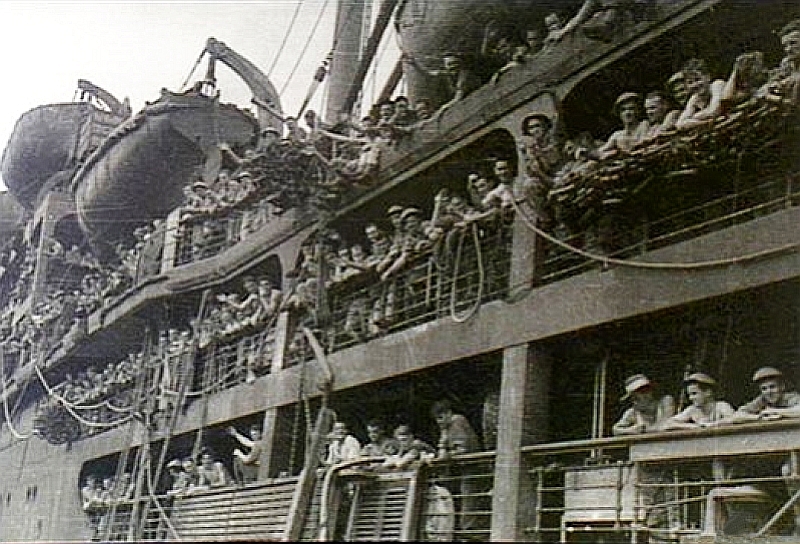
Here
we see Australian and British troops on board the Orcades (II) in
1941
Australian
War archives
HMT Orcades under the commanded of Captain
Charles Fox departed Liverpool on a grey day in the early autumn
of 1942 for a voyage to South Africa and sadly it was to be her
last voyage. Having arrived safely, Captain Fox was unaware that
late in August that four German U-Boats, including the U-172 had
left their home ports bound for the busy sea lanes off Cape Town.
Their mission was code named “Operation Polar Bear” and
the idea was to create total havoc for all Allied shipping to and
from the Cape, and they had orders that they were not to
engage in action before October 8th, 1942.
Sadly the Orcades departed Cape Town on October
9, 1942, then on the next day the 10th at about 11:30
in the morning she was suddenly hit by 2 torpedoes from the
German U-Boat - U-172, however Orcades was not badly damaged and
did not sink. Then came a third torpedo, but it missed, a fourth
torpedo soon followed and that one was a direct hit and on target
doing a great deal of damage, which meant a call from the Bridge
to “abandon ship.” She commenced to sink rapidly and
she settled beneath the waves around 14:00.
The Orcades had a complement of 1,067 on board,
after the sinking there was a loss of 45 lives, but thankfully
there were a good 1,022 survivors who were picked up by the SS Narvik
being a Polish steamship of 7,000-tons. Apparently the U-172 was
a 9C type submarine, commanded by Captain Carl Emmerman was born
in Hamburg in March 1915.
For comprehensive details of the attack and
sinking of the HMT Orcades (II) please visit: www.uboat.net/allies/merchants/2258.html.
********************************************
RMS
Orcades (III):
Orient Steam Navigation Company (Orient
Line) 1948-1966.
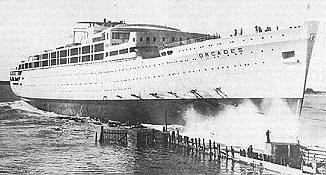 With the tragic loss of Orcades
(II) Orient Line decided to build a new and a larger ship of the
same name. They decided to take the best of the original design,
but vastly modernise this new ship and the outcome became the new
template for the next two new Orient Line ships, being the
Oronsay (1951) and the last of the trio, the much improved
version the Orsova (1954).
With the tragic loss of Orcades
(II) Orient Line decided to build a new and a larger ship of the
same name. They decided to take the best of the original design,
but vastly modernise this new ship and the outcome became the new
template for the next two new Orient Line ships, being the
Oronsay (1951) and the last of the trio, the much improved
version the Orsova (1954).
Here we the Launching of the Orcades on
October 14, 1947.
The order to build the new Orcades was given
once more to the builder who had constructed Orcades (II), which
had been completed in 1937 being Vickers Armstrong Ltd at Barrow-in-Furness
and her hull was laid down in yard 950.
She was launched in October 1947
and was completed just over a year later on November 14,
1948. She underwent her deep sea trials that same month and
achieved a respectable 24.74 knots. The cost to build the RMS
Orcades was £3,418,000.
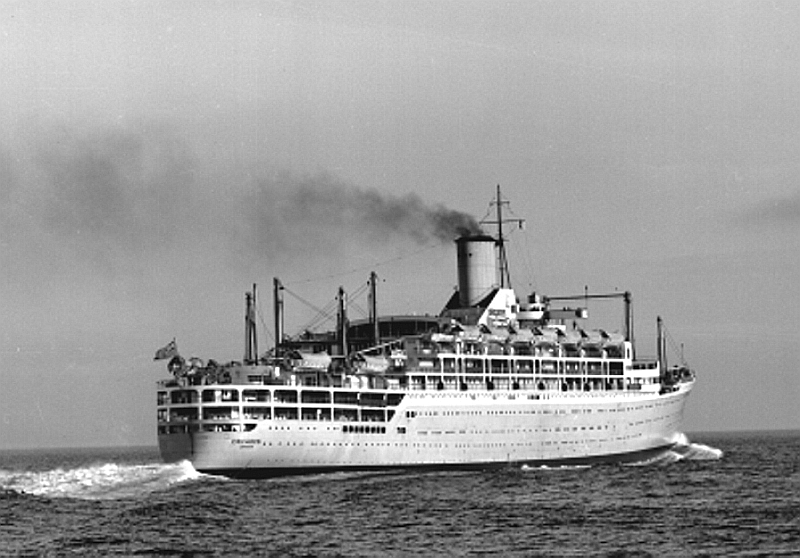
Orcades
seen during her sea trails
The Orcades was the very first post war
passenger liner built for Orient Lines and it should be known
that she shared her hull with the P&O Lines Himalaya (1949),
however Orcades’ superstructure was quite different indeed,
for this ship commenced had a commenced a totally new look for
Orient Line liners, considering that now the bridge had been located
almost amidships and it was crowned by a tripod mast with an
upright funnel, that had just a slight angle that sat up high
directly aft of the tripod mast.
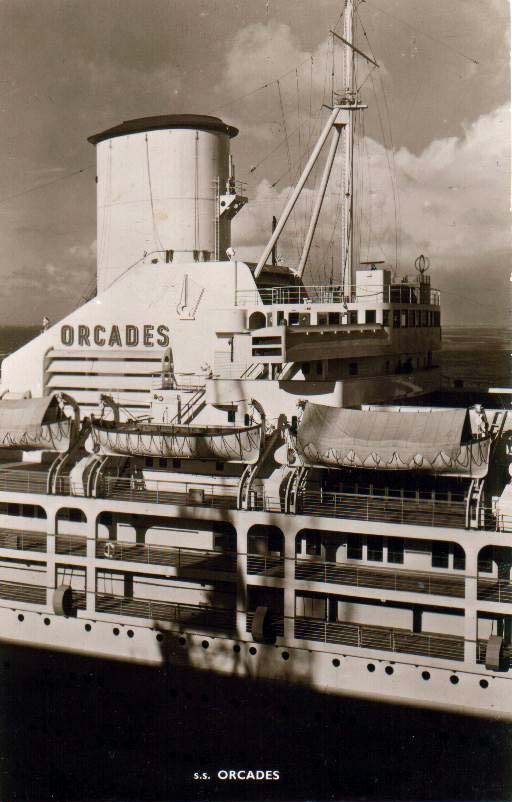
A
view of her amidships Bridge, the tripod mast and funnel
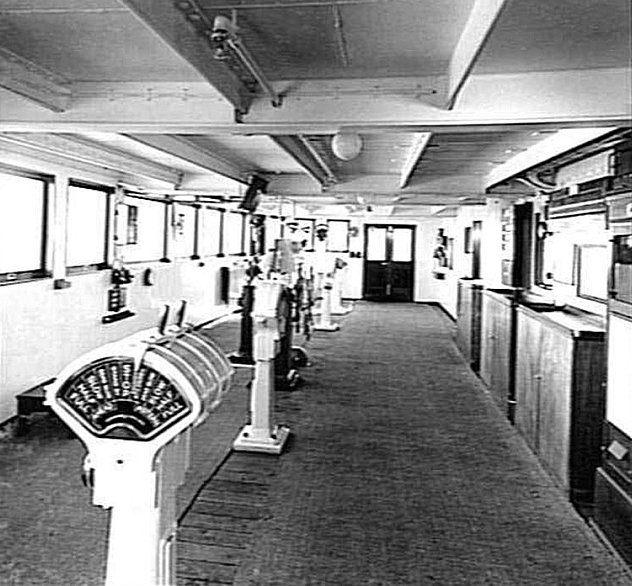
The
vital part of the ship located amidships is Orcades’ Bridge
In addition the traditional two tall (main)
masts were also been done away with, instead there were four king
posts forward and aft with their respective derricks to handle
cargo. All this combined with a new glazed in first class Stadium
Look-out forward of the Stadium sports deck, and this gave her
that unique look of the new Orient liners of the 50s!
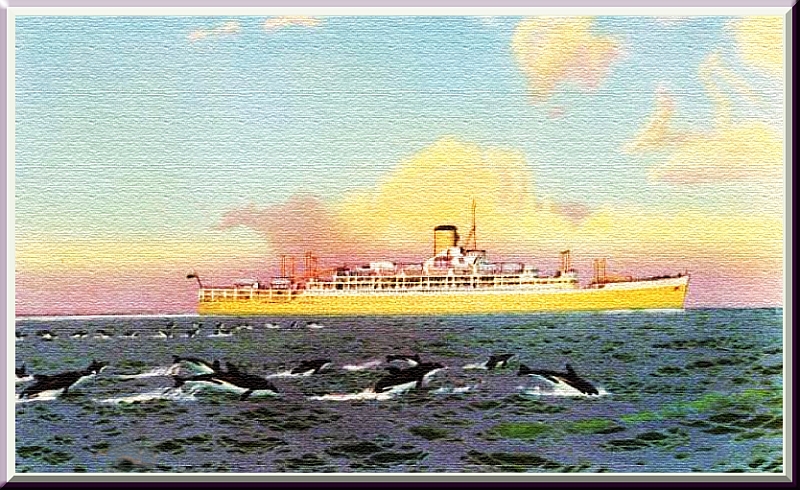
This
is the first artist impression released of Orient Lines new liner
RMS Orcades revealing
A
new look of the Orient Line liners without their traditional tall
masts
There was no doubt that the Orcades set a new
standard in style externally at the time, but also she offered
high standards in her facilities and accommodations. She offered
many fine lounges as well as other facilities such as shops, hair
saloons, hospital, swimming pool, and a vast range of cabin
choices.
Countless immigrants sailed to Australia ton
the Orcades and they have emailed the author regarding her
delightful style and that feeling of “old world style of
luxury” that they experienced whilst they were on board,
regardless if they where in First or Tourist, or even later
when she had become a One Class ship! But as built she was a Two
Class ship and offered accommodations for 773 First Class, and
772 Tourist Class passengers.
Before we continue with her history and even
with her maiden voyage, let us go on board and discover this
understated, yet elegant liner!
Orcades
Photo Album 1948 including the 1959 refit
Please
Note: all exterior images of the ship are of her prior to the
1959 refit & the funnel extension!
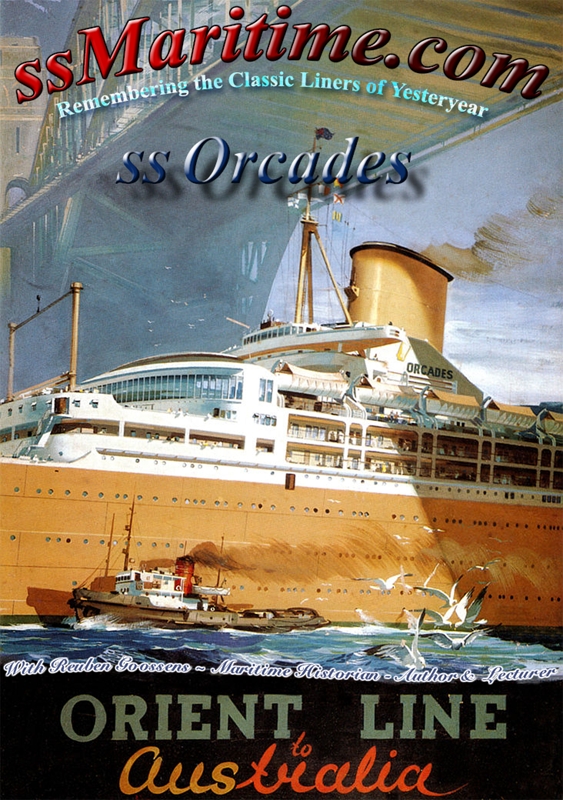
Minus
the ssMaritime data, which the author added … this was the
Original poster promoting Orient Lines and their two new liners
The
… RMS Orcades and the soon to arrive RMS Oronsay
new services to Australia
First
Class
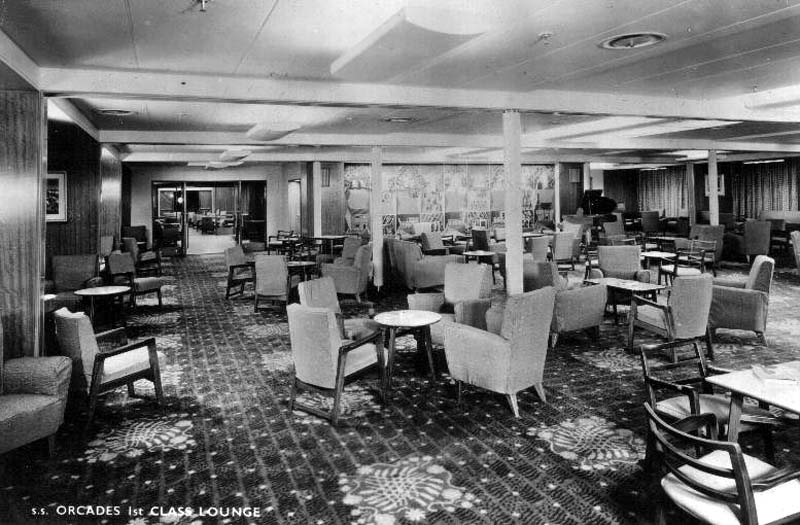
Main
Lounge - looking aft to the Lobby and Galleries on both sides
leading into the Ballroom
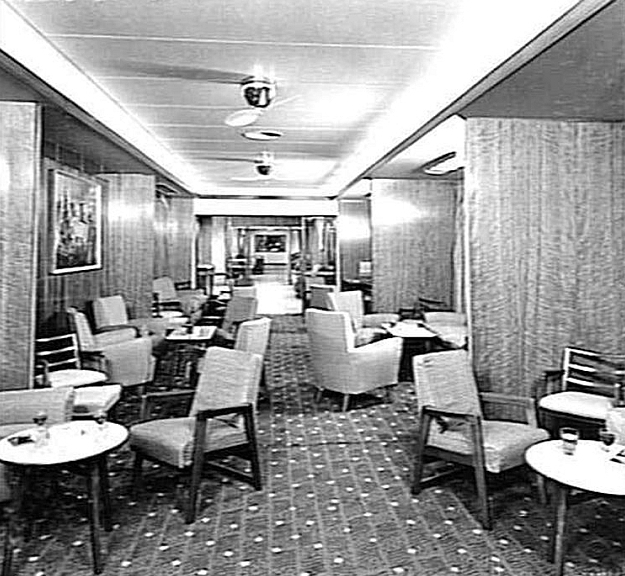
The
Gallery between the Main Lounge and the Ballroom
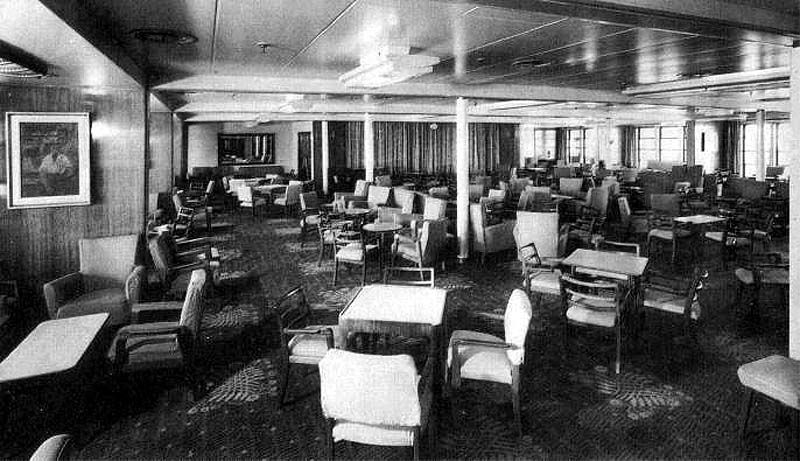
Main
Lounge – looking forward
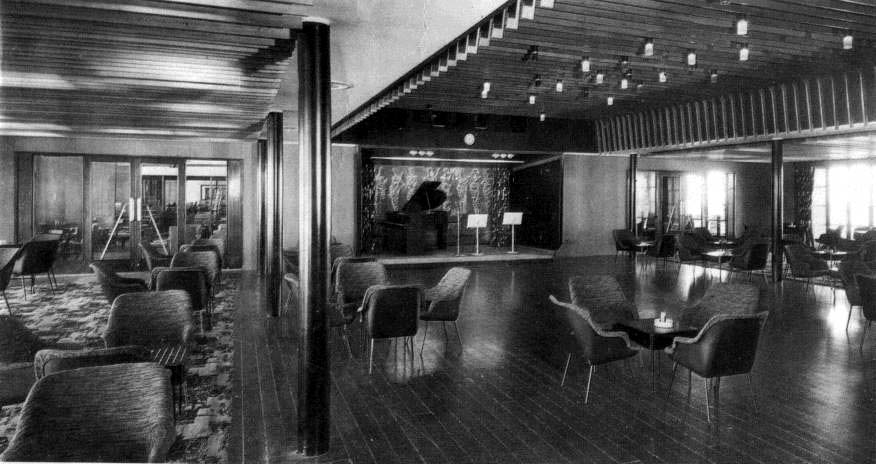
The
Ballroom – looking forward in the Galleries
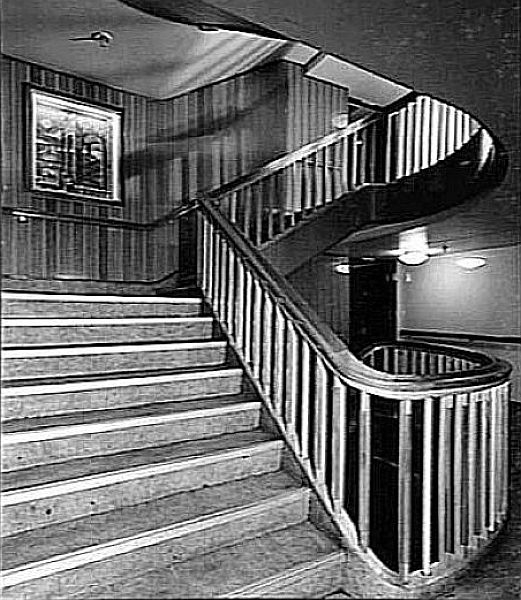
Aft
stairwell
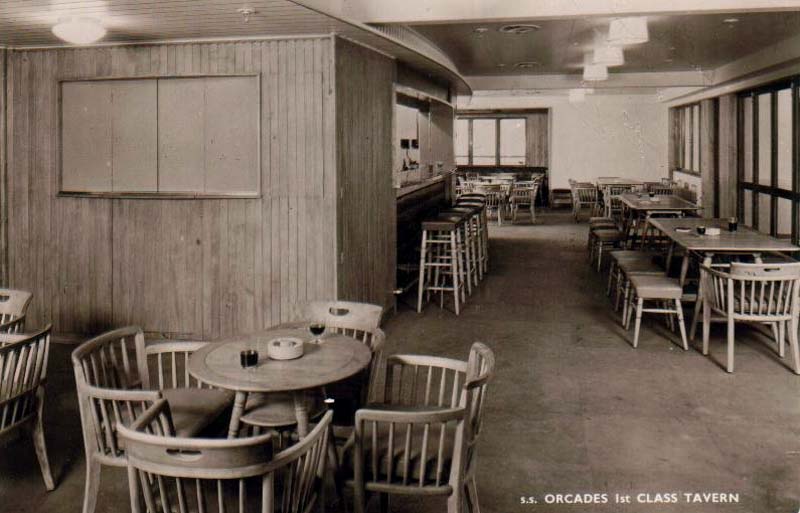
Further
aft is the Tavern
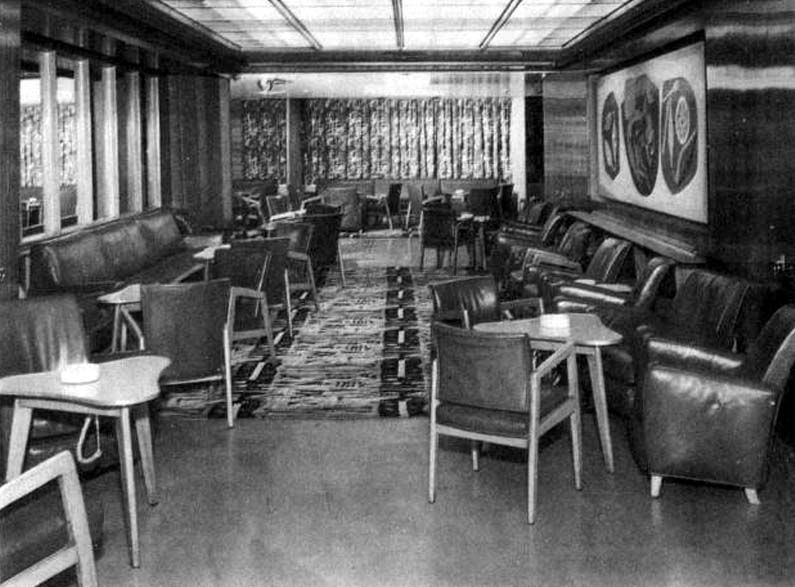
The
ever popular Bamboo Room
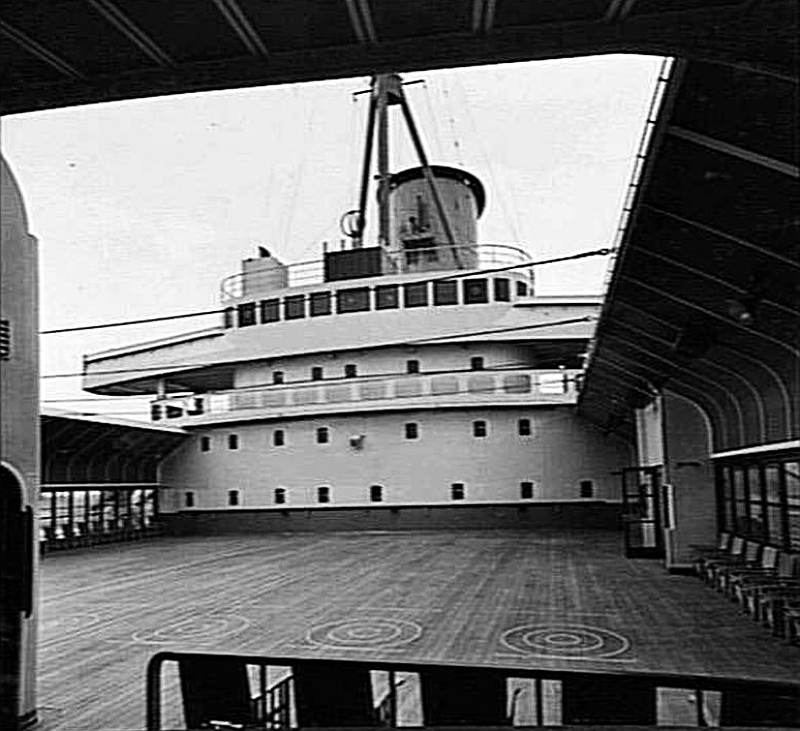
Far
forward is the Stadium and the glazed Look-out far forward, which
in later ships became the “Crows Nest”
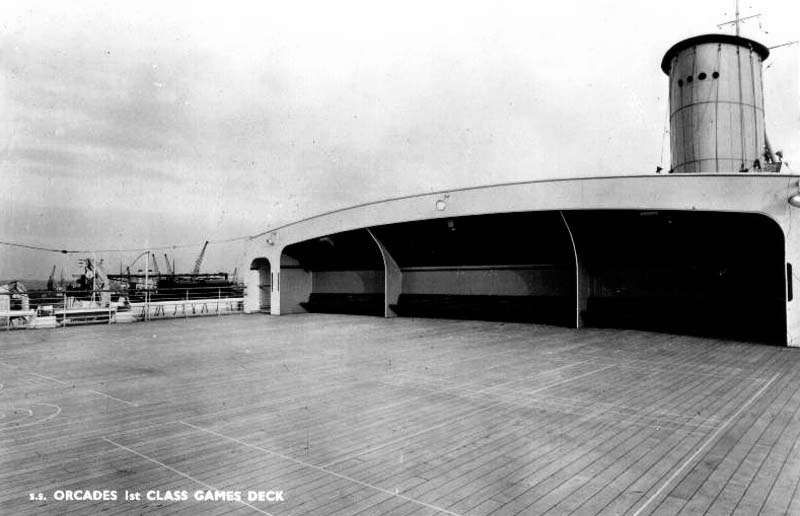
Games
deck was very spacious
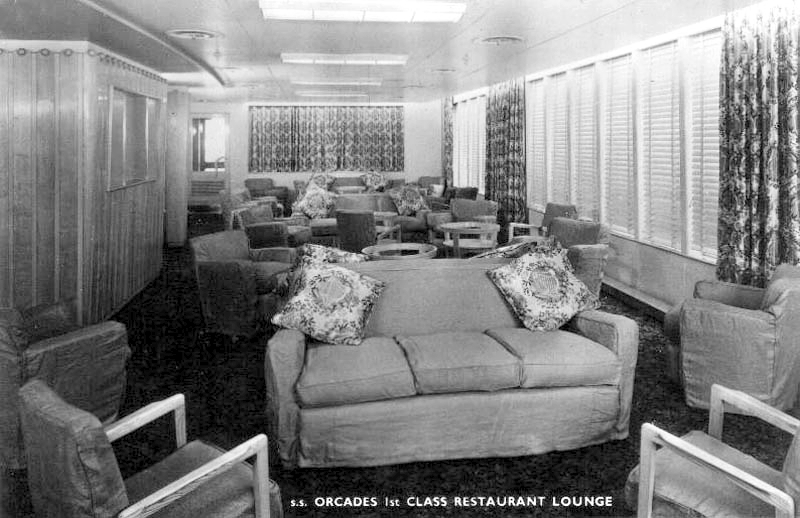
Up
on Stadium Deck the Grill Restaurant and its special Lounge was
located far aft
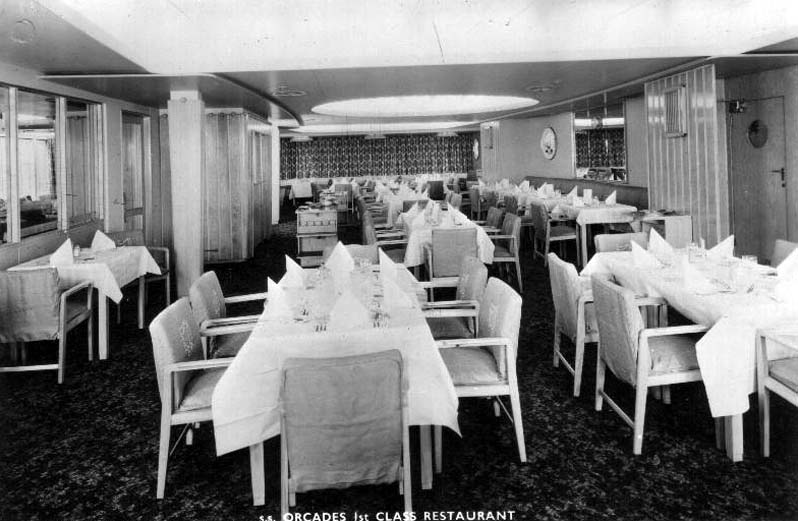
The
Grill Restaurant overlooked the aft decks
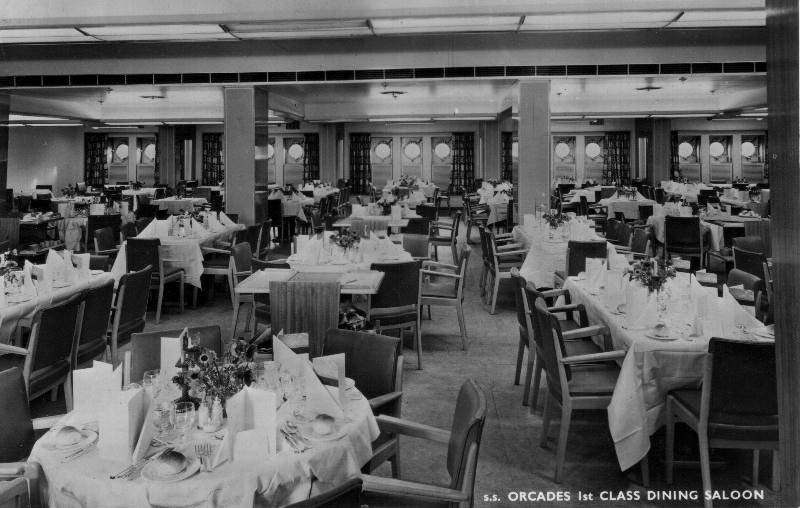
The
Main Dining Saloon
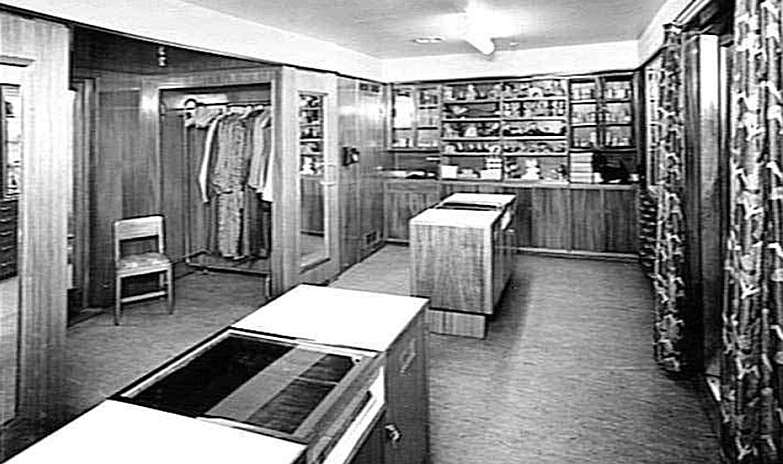
The
Shop
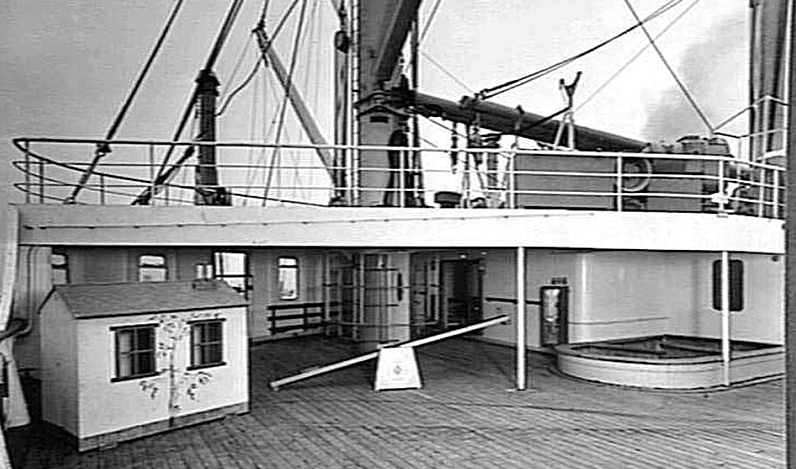
Children’s
Playground
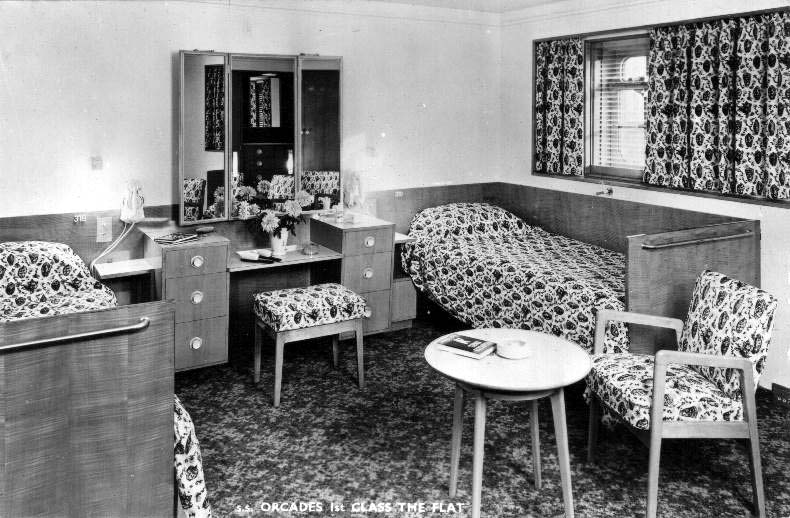
The
Flat is one of the deluxe suites, this is just the bed room, and
there is also a spacious lounge as well as a lobby
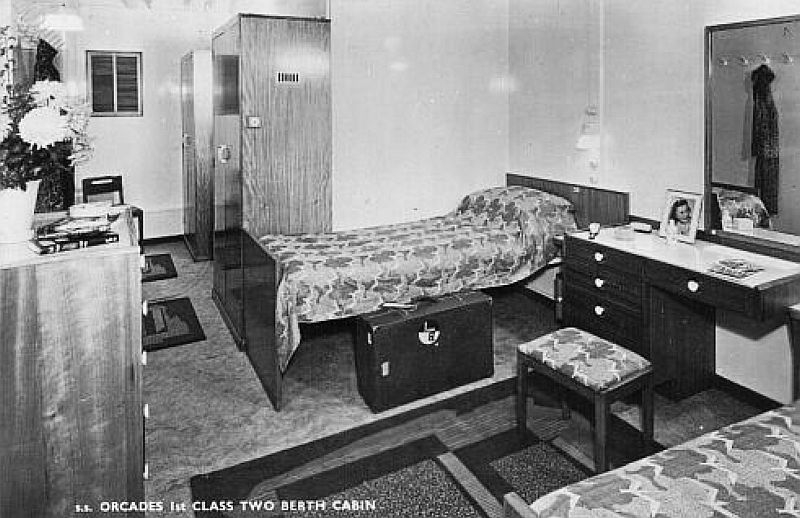
An
outside twin bedded cabin
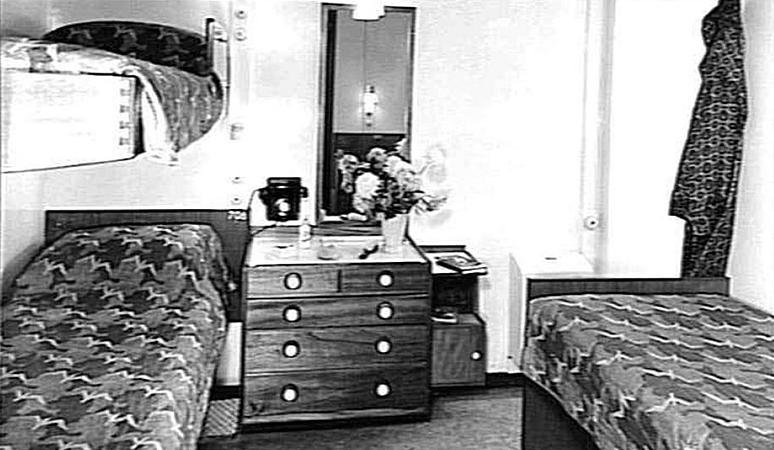
Inside
twin or three berth cabin
Tourist
Class
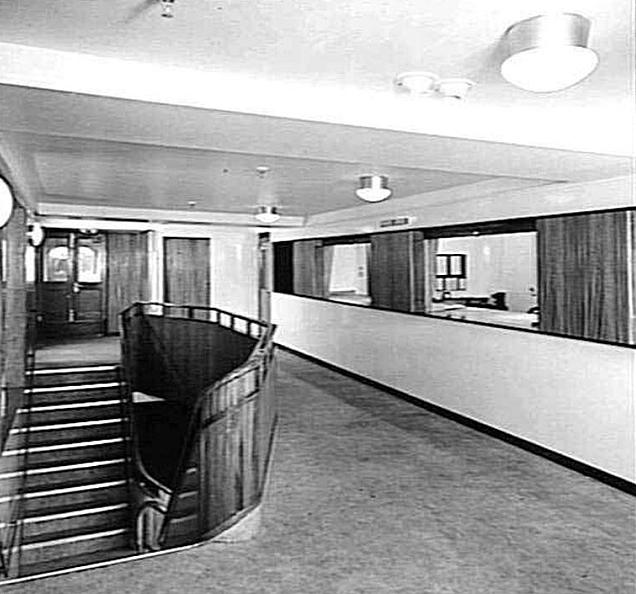
The
Tourist main entrance and the Pursers Office
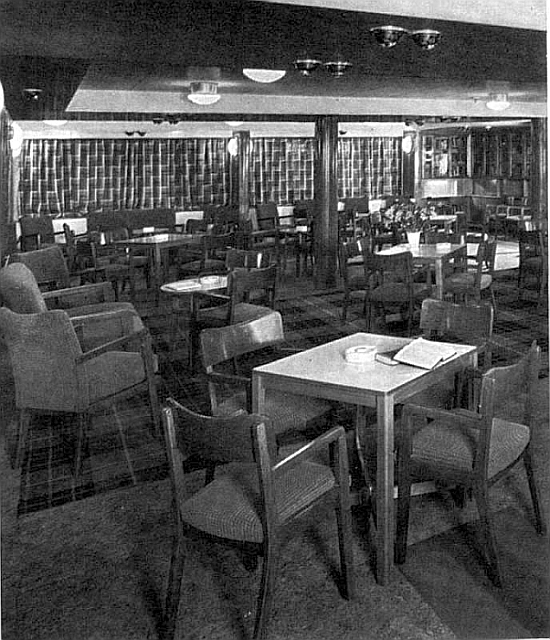
Main
Lounge
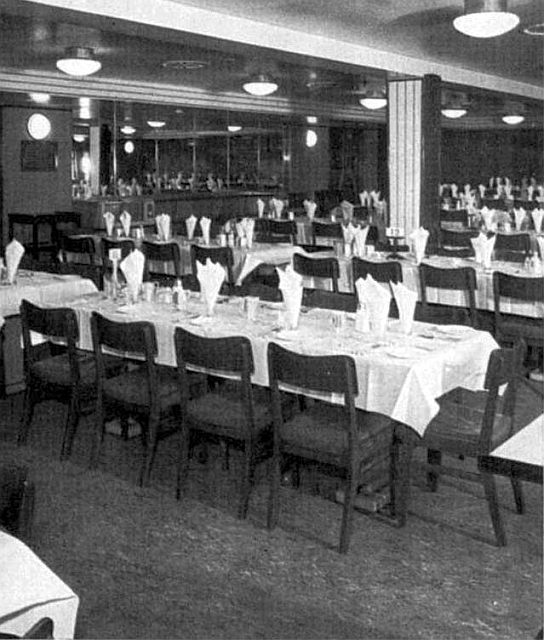
Dining
Room
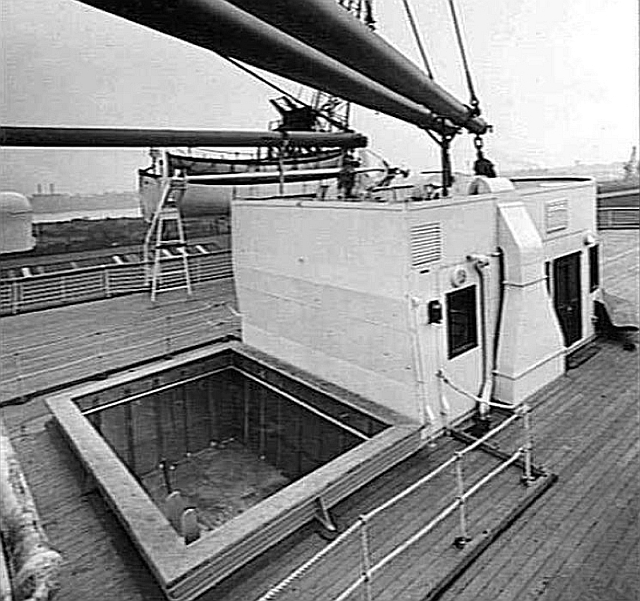
The
pool was originally the first class pool until the 1959 refit
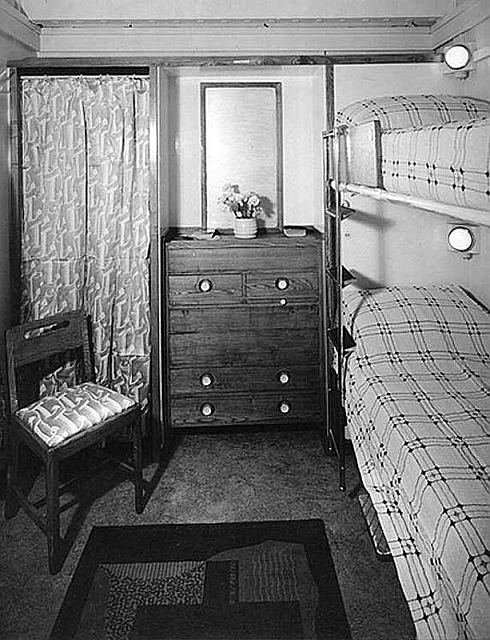
Inside/outside
single/two berth cabin
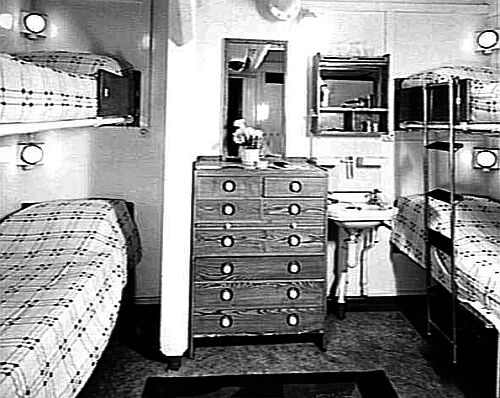
Inside/outside
twin/three or four berth cabin
The RMS Orcades was certainly a powerful ship
as she was fitted with powerful steam geared turbines, built by
the ship builders, which combined with the twin screws gave her
an excellent speed of 24.74 knots, but she operated at a
comfortable service speed of 22 knots when in service.
She departed on her maiden voyage from Tilbury
on December 14, 1948, being her first voyage, sailing to Australia
and Auckland New Zealand via Gibraltar, Naples, Port Said, Aden, Colombo,
Fremantle, Adelaide, Melbourne and Sydney where she arrived on
January 13, 1949, and then continued to Auckland New Zealand,
where she would turn around and head back to the UK.
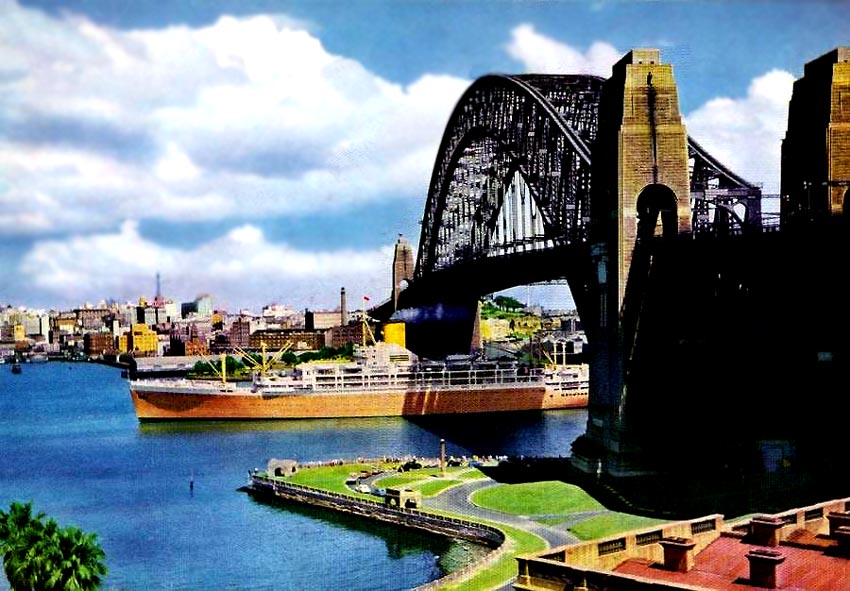
An
Orient Lines Postcard of the Orcades departing Sydney whilst on
her maiden voyage in January 1949
Amazingly the Orcades was the very first brand new
liner to reach Australia after the war. She continued on this service
for the next six years and continued to gain more and more
popularity amongst Australian’s and New Zealanders!
You will have noticed that the Orcades was
prefixed RMS, thus obviously she was employed on the mail service
between Britain and Australia, in addition she would carry
government, business and general full fare paying passengers who
were either on vacation or visiting friends or relatives in
Australia or New Zealand. Being a British ship she also had a
contract to operate as an immigrant transport ship, with most of
these passengers being accommodated in Tourist Class, either in
the larger cabins, or at least four berth cabins. She carried
immigrants from her very first (maiden) voyage.
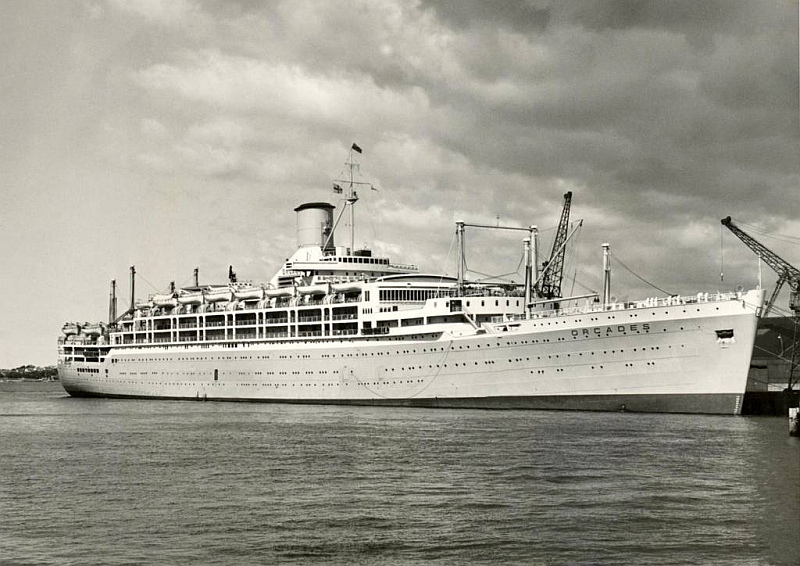
Orcades
is seen in Auckland in 1952
During her time on this service sailing via the
Suez Canal to Australia, the only incident to mar her perfect
record occurred on May 7, 1952 when she ran aground in Port
Philip Bay, Melbourne, however, she was soon pulled free by four
tugs and there was no damage whatsoever and she continued her
voyage!
But in 1954 both Orient Line and P&O
introduced new services having some of their ships sailing across
the Pacific. Thus with Orcades having arrived in Sydney from the
UK, she departed Sydney on December 17, 1954 and operated a
“Circle Pacific Voyage,” cruising via a variety of
ports to San Francisco where she arrived on January 6, 1955. She
then returned to Sydney after which she then returned to the UK
via the Suez as per usual.
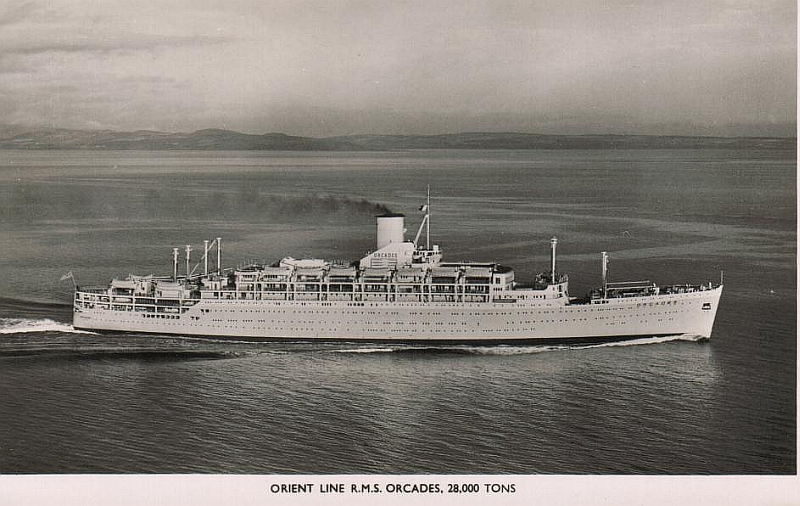
An
Orient postcard showing her prior to her upcoming refit, minus
the new funnel fitting
Then in 1955 Orient Line decided to change her
service altogether and operate the Orcades on an around the world
service westwards, thus she departed London for her very first
sailing to New Zealand and Australia via the Panama Canal on
August 22, 1955 and having arrived in Australia she would then
return to the UK sailing via the Suez Canal. During the Olympic
Games in Melbourne in November 1956 the Orcades remained for the
duration as an accommodation ship, and thousands of people from
all over the world enjoyed her many comforts.
1959
Refit:
During her 1959 refit she went to the Harland
& Wolff shipyards in Belfast where the ship was fitted with a
“Stovepipe” atop her funnel, something that also became
known as a “Top Hat” that would improve the dispersion
of smoke from her aft decks. Considering her funnel being very
high on the ship, now with this new “Stovepipe” the
funnel looked even taller than it did before.
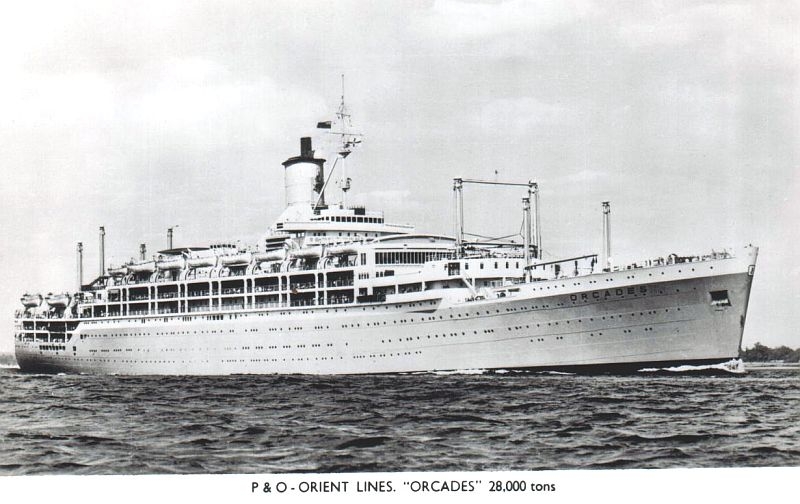
First
black and white postcard of the Orcades showing her
“Stovepipe” “Top-Hat”
Internally air-conditioning was extended
throughout the entire ship, which was a massive improvement to
the comfort to all passengers, considering the time she spent in
tropical waters. In addition a brand new First Class Tavern and a
new swimming pool were built, whilst the former ones were now
allocated to Tourist Class. Upon completion her new tonnage was
now officially registered as being 28,399 GRT.
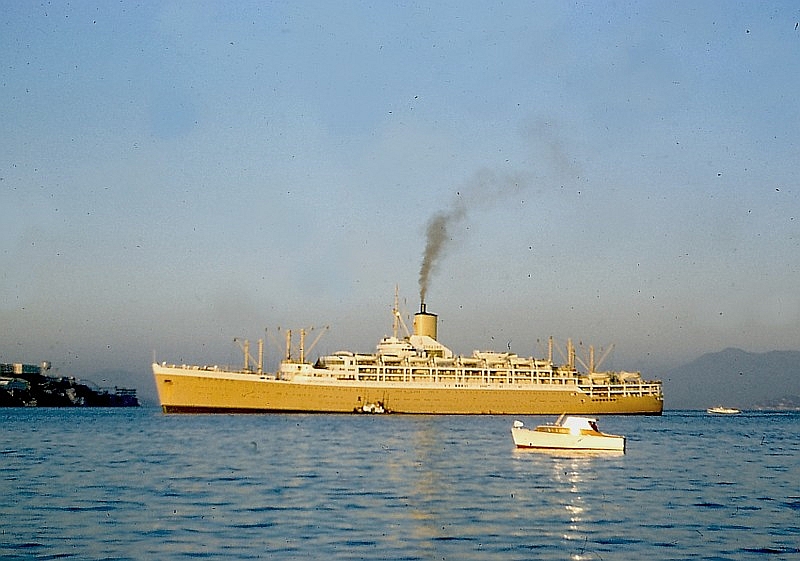
SS
Orcades seen at San Francisco
Peninsular and Oriental Steam
Navigation Company (P&O) 1960-1972.
The Orcades and she returned to her regular
around the around the world services, but in 1960 Orient Line
came into the ownership of P&O Line after they had taken over
the balance of the Orient Line shareholding. The order came that
all Orient Line ships were to change their livery to all white as
soon as possible, but somehow the now designated SS Orcades
managed to hold out for a good four years, thus retaining her
original Orient Line corn coloured hull until 1964, being her
next refit.
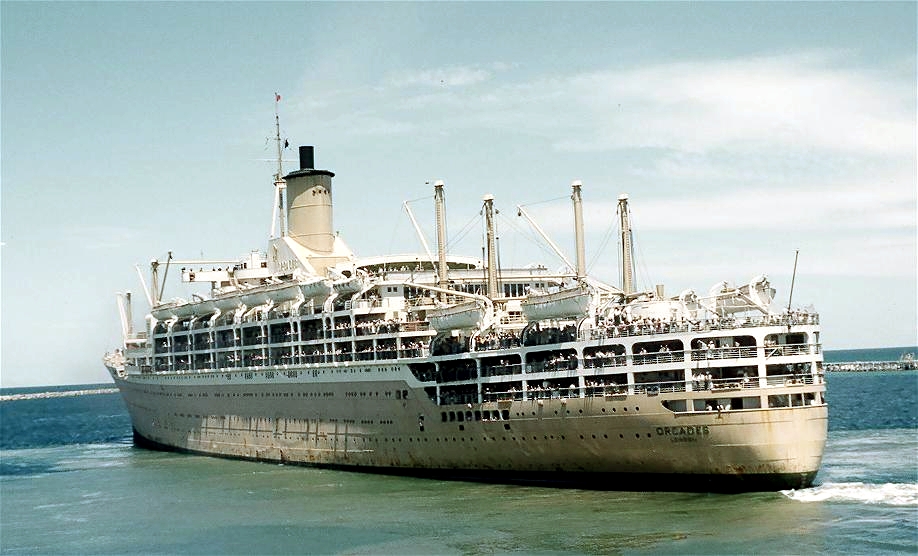
This
photograph shows the many sheltered decks available to passengers
on a real ship
something
that is missing on the modern floating cruise (square)
apartment/resort vessels/boxes!
Photographer
unknown – Please photo notes below
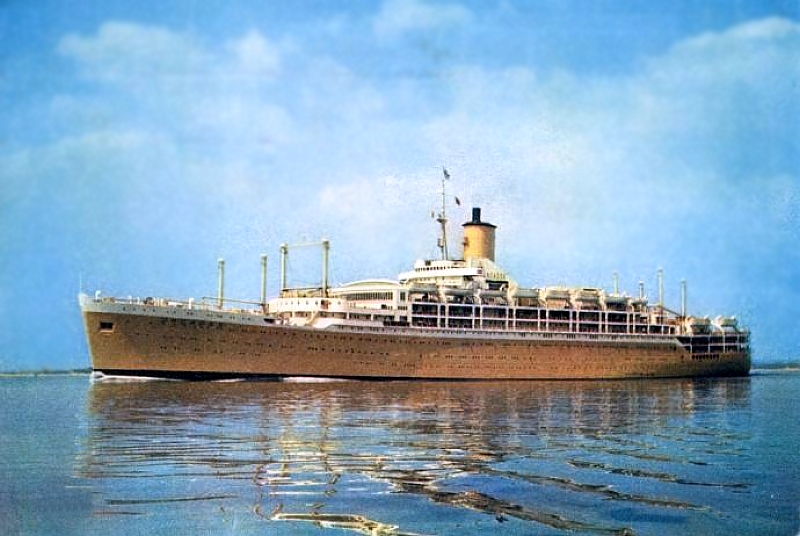
P&O
colour postcard of the SS Orcades available on board
1964
Refit:
During this refit the idea was to change her two
class configuration and change her into a One Class ship with accommodations
for 1,635 passengers. In addition her former First Class
Grill Lounge was rebuilt into a Cinema with 157 seats and the
actual Grill became the Cinema Lounge with a view over the aft
decks. The First Class Main Lounge was renamed the
“Riverina Room” only other changes would be minor, such
as soft furnishings, etc.
The most obvious external change would be her
external livery, for Orcades traditional Orient Lines corn hull
would disappear and become the typical P&O all white hull and
superstructure with red boot topping, but thankfully the
corn/yellow funnel with its black cover and “top-hat”
remained!
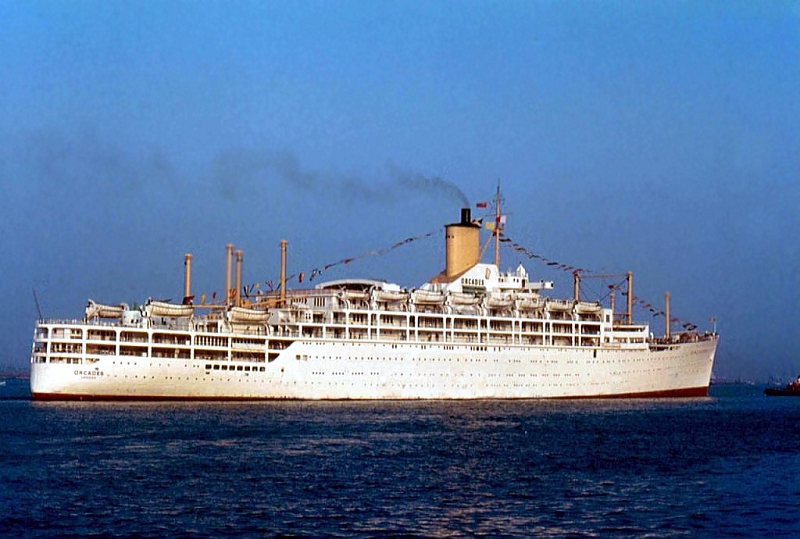
The
new look cruise ship SS Orcades
Having been completed, the all white SS Orcades
departed Tilbury on her first voyage in May 1964 and continued on
her regular Australian Line voyages sailing westward. However,
with the airlines taking over the migrant trade it became obvious
that line voyages were suffering and that it was the cruises that
were making the most money for the big shipping companies, thus
the SS Orcades soon became better known as a happy and an
excellent cruise ship, rather than having been a traditional
liner. Hough she still operated the occasional voyage to and from
the UK and Australia, but they were more like relocation voyages
for upon arrival at her destination she would commence a series
of summer cruises out of Sydney, then 4 months or so later return
to the UK and operate further cruises from there, as well as out
of the USA.
The
End is Near:
Her Australian cruises proved to be very
popular, be they those to the South Pacific or the longer Asian
cruises. However on April 17, 1972 during one of these cruises
whilst Orcades was in Hong Kong, sadly there was a fire in her
boiler room. Although this did not affect the rest of the ship,
but vital parts were required for her to continue. As it turned
out the P&O’s SS Iberia had already been laid up at
Southampton, thus they took the badly needed parts from her and
they were flown to Hong Kong and she was repaired and continued
her voyage.
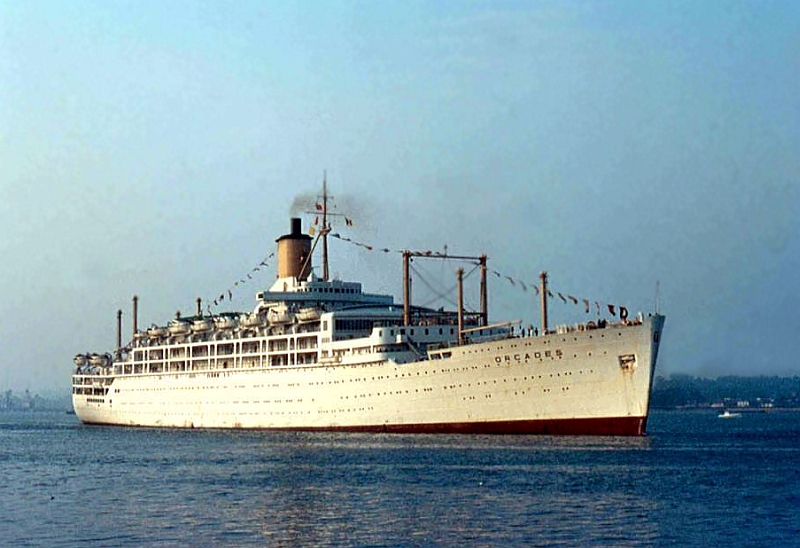
Here
we see the Orcades heading towards the end of her days
However, it turned out that this fine ship was
heading towards her final days and although she did operate
further cruises, she departed Sydney for the final time on June
3, 1972 and she sailed for England. Upon arrival in Southampton
she made a good number of summer cruises with the last one
returning on October 13, and P&O decided to take her out of
service and place her in lay up and on the market.
The RMS Orcades, the ship that was considered
to be a ship of the future during her day, had been taken over by
far superior ships such as the great and ultra modern SS Oriana
and elegant and super sleek SS Canberra. All too soon the still
beautiful Orcades was sold to “Nan Feng Steel
Enterprises” being Taiwanese ship-breakers.
SS Orcades departed on December 28, 1972 with
just a skeleton crew on board bound for the ship breakers in Taiwan.
She arrived in Kaohsiung on February 6, 1973. Breaking-up of this
the Orcades, once great liner and cruise ship, commenced on March
15, 1973.
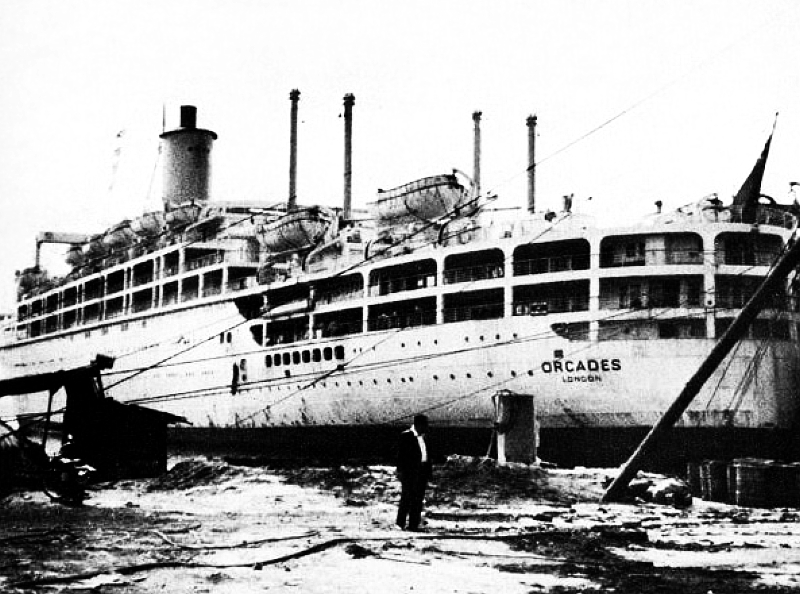
Orcades
is seen here at the breakers yards as they are dismantling her
interiors
But
soon the blow torches will cut her up and she will be no more
Photographer
unknown – Please photo notes below
SS
Orcades (III) Specifications:
Built by:
Vickers Armstrong Ltd, at Barrow-in-Furness.
Yard:
950
Launched:
October 14, 1947
Tonnage:
28,164 GRT / 1959 - 28,399 GRT (Gross Registered Tons).
Dead Weight:
11.140 d.w.
Length:
709ft – 216m.
Width:
64ft – 27.6m.
Draught:
30.5ft – 9.4m.
Motive power:
6 x single reduction steam gear turbine engines by her builders.
Screws:
Twin – 24,000 BHP.
Speed:
22 Knots – Max 24.74 at trails.
Passengers:
1948 - 773 First Class & 772 Tourist Class / 1964 - 1,635 One
Class.
1948 - Partial Air-conditioned / 1959 - Fully Air-conditioned.
Fully Stabilized.
In
Conclusion … Memories!
I trust that this RMS/SS Orcades feature will
have provided you with some good memories, regardless if you
sailed on her or not. She was a wonderful sight to behold
whenever she was in port, be it in Australian, New Zealand, the UK
or some port around the globe. For frequently locals would often
go the wharves and look at the great liners and dream, thinking
“One days maybe I might be on a ship like this.” And
often, many did at a later time! As a small child I recall
looking at a particular ship that I loved for some reason and had
that very same wish “One day”, etc. Well, I ended up
sailing on that very ship from Rotterdam to Wellington New Zealand
departing on May 17, 1958 and thus my dream came true within one
year! Others may have sailed although much later on a newer and
more modern ship, but looking at one of these fine liners may
have started the idea of taking a cruise vacation!
But for those who sailed on her, I am sure you
will have enjoyed looking at some of those original interior
photographs of her lounges and other venues, which were taken
during the days she was still a two class liner. Sadly I do not
have much of her after her refit in 1964, except for the exterior
images.
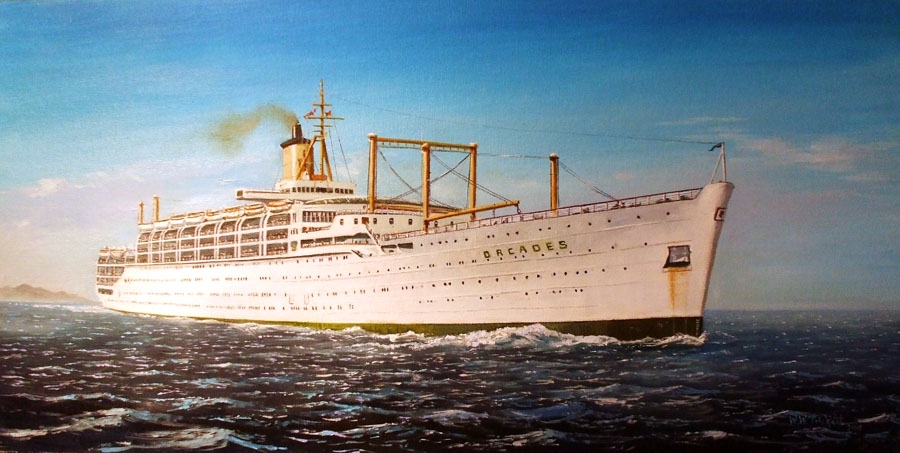
A
superb painting by a dear New Zealand friend Wallace Trickett
Visit
Wallace Trickett’s website - Email
Wallace at: wallace.t@paradise.net.nz
SS Orcades (III) made countless voyages to Australia
between 1948 and 1972, first sailing via the Suez Canal. Then
from 1955 she commenced her world voyage by first sailing via the
Panama Canal and returning to the UK via the Suez Canal. During
the Olympic Games of November 1956, Orcades spent two weeks
berthed in Melbourne and was used as a floating hotel which was
extremely successful for during this time she accommodated
thousands of visitors to Australia from all over the world. In
addition, as from 1964 she proved to be a greatly loved and a
popular cruise ship by Australian’s, New Zealander’s,
American’s and of course the British, all of whom the
Orcades served so well!
SS Orcades (III) was a ship that is still
greatly loved by so many and she will be remembered as Britain’s
very first post war new liner to be built especially for the
Australian service!
****************************
Use
the Back button on your browser or Close the Page to return to
the previous page
or go to our INDEX
Also
Visit our Features on the following Orient Lines/P&O Ships
Orient
Lines: RMS Orcades – SS
Oronsay - SS
Oriana - RMS
Orion
P&O:
RMS Strathaird - SS
Iberia - SS Canberra
There
May be more since this page was created – See our MAIN INDEX
****************************
Visit our ssMaritime
Main INDEX
Where
you will discover more than 627 Classic Passenger &
Passenger-Cargo Liners!
ssMaritime.com & ssMaritime.net
Where
the ships of the past make history & the 1914 built MV Doulos
Story
Also
visit my
“Save The
Classic Liners Campaign”
Please
Note: ssmaritime and associated sites are 100% non-commercial
and the author seeks no funding or favours of any shape or form,
never have and never will!
Photographs
on ssmaritime and associate pages are by the author or from
the author’s private collection. In addition there are some
images that have been provided by Shipping Companies and private
photographers or collectors. Credit is given to all contributors.
However, there are some photographs provided to me without
details regarding the photographer/owner concerned. I hereby
invite if owners of these images would be so kind to make
them-selves known to me (my email address may be found on www.ssmaritime.com only), in order that due
credit may be given.
ssMaritime
is owned & © Copyright by Reuben Goossens - All Rights
Reserved.












































